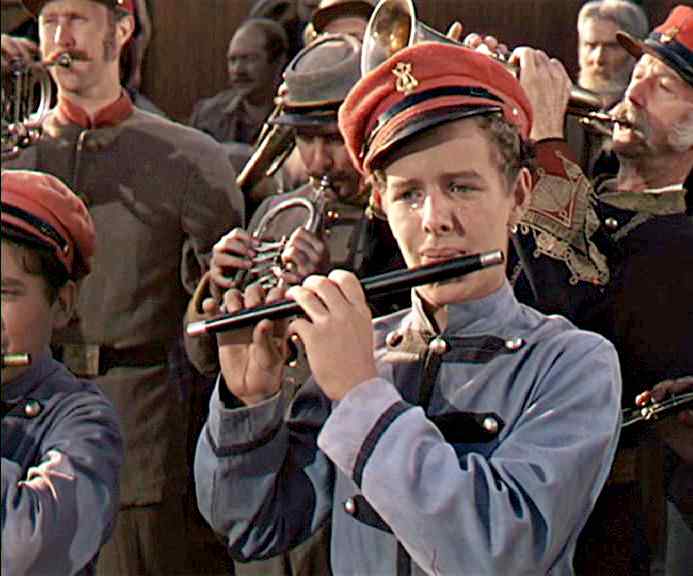
Gone With the Wind (United States, 1939)

Figure 1.-- Tommy Kelly made a brief appearance as a Confederate band member. Tommy was not precisely a child star, but he was used by the studio in several films during the 1930s and 40s. We are not sure just what kind of band is depicted here. It is perhaps some kind of band maintained by a larger military unit. More common and more important were the musicians attached to Civil War regiments. They were often quite young boys ad played a key role in battlefied communications.
|
The Civil War epic "Gone With the Wind" is one of the greatest movies in Hollywood history. It was the first great color film. Characters from the film like Scarlett O'Hara and Rhett Butler are some of the most legendary in film history. We do not recall any boys with important roles in the film. A reader tells us that Tommy Kelly made a brief appearance as a Confederate band member. Tommy was not precisely a child starr, but he was used by the studio in quite a number of filns during the 1930s. The one child role I recall is Scarlett and Rhett's little girl. "Gone With the Wind" is the best known of the many Civil War films. It is clearly a great film. It is not, however, a very historically accurate film. This is unfortunate because the view of the Civil War by many people is significantly affected by the film.
Filmography
The Civil War epic "Gone With the Wind" is one of the greatest movies in Hollywood history. It is one of the films that consistently appear on lists of Hollywood's best films. It was the first great color film.
Cast
Characters from the film like Scarlett O'Hara and Rhett Butler are some of the most legendary in film history. Scarlett is played by beautiful Vivien Leigh. Here performance is stunning. Unfortunately she did not have a long Hollywood career because of mental problems. Rhett was played by Clark Gabel. Ashley Wilkes who Scarlett wanted was played by English actor Leslie Howard. Both Gable and Howard served in Wold War II. Howard was killed. We do not recall any boys with important roles in the film. A reader tells us that Tommy Kelly made a brief appearance as the boy in front of the examiner's office and then as a Confederate band member (figure 1). Tommy was not precisely a child starr, but he was used by the studio in several films during the 1930s and 40s. The one child role I recall is Scarlett and Rhett's little girl.
Plot
The film is essentially the saga of a flirttous Southern girl--Scarlett O'Hara.
She is both flitatous and self centered, but a great strength of character emerges whatever her morals. Despite her flaws she is still one of the great heroines in film history. Apparently public attitudes provide wider mrgins for female herones.
Scarlett is madly in love with Ashley Wilkes, but he marries Melanie Hamilton (Olivia de Havilland) in one of many superp performances in the film. Scarlett encounters an outsider--Rhett Butler. Rhett is not drawn up in the war fever. He understands Charlott, but yet falls in love with her. They marry because Scarlett believes he has money. Melanie and Scarlett become friends despite Scarlett's desires for Ashley. Then the action shifts to Scarlett's desire to hold on to Tara--the family plantation.
The Civil War
"Gone With the Wind" is the best known of the many Civil War films. It is clearly a great film. It is not, however, a very historically accurate film. This is unfortunate because the view of the Civil War by many people is significantly affected by the film. One of the serious faults of the film is that it essentially ignores slavery. No where in the film is the brutality and horror of slavery depicted which is essentially in understanding the period. The film offers no suggestion that the wealth and splendor of the antebellum South so splendidly depicted in the early scenes was based on slavery. Nor is slavery presented as the cause of the War.
Two slaves have prominent roles, including the great Hattie McDaniels. (Who was essentially segregated at the Academy Award ceremony where she received her Oscar). Now I would not say that no slaves had the status she had on Southern plantations. I would say that this was the exception and not the rule. Another substantial historical inaccuracy is the depiction of Reconstruction. This is even more flagrant. Slavery is ignored. The film presents Reconstruction in some detail, essentially adopting the Lost Cause view of Reconstruction. There is also a scene with the extra-legal violence used by white racists to seize control of state governments. This is essentially a dressed up depiction of a Klu-Klux-Klan raid. Here again the film provides a highly sanitized view of Lost Cause historians.
Costumes
One of the many strengths of the film is the elaborate costuming which as far as I can tell was essentially accurate. Unfortunally few children appear in the film. There were no boys with prominent roles depicted, by Charlott and Rhett's little girl appears in several scenes.
Civil War Musicians
We are not sure just what kind of band is depicted here. Perhaps some kind of band maintained by a larger military unit. More common and more important were the musicians attached to Civil War regiments. They we often quite young boys ad played a key role in battlefied communications.
HBC

Navigate the Boys' Historical Clothing Web Site:
[Return to the Main "Gm-Gq" movie page]
[Return to the Main alphabetical movie page]
[Introduction]
[Activities]
[Biographies]
[Chronology]
[Clothing styles]
[Countries]
[Bibliographies]
[Contributions]
[FAQs]
[Glossaries]
[Satellites]
[Tools]
[Boys' Clothing Home]
Created: 10:44 PM 5/21/2006
Last updated: 10:44 PM 5/21/2006



